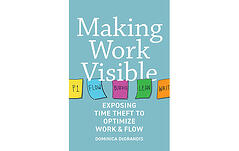Have you ever wished there were more hours in the day? If so, you’re not alone. The problem isn’t that there are not enough hours, but that your time is being stolen. Saggezza highlights the five most common thieves of time and useful tips to alleviate daily workflow stress in DeGrandis’s Making Work Visible.
1. Too much work in process (WIP) is defined as work that has been started but has not been finished. We tend to offer help and time to others, because we do not want to disappoint colleagues who have helped us out in the past. As Warren Buffet once said, “very successful people do say ‘no’ to almost everything.” Not offering to help, or refusing to help when asked, is risky to do in today’s culture which promotes collaboration and teamwork. However, too much WIP leads to lower cycle times – the amount of time an item sits being worked on, and content switching – moving from one task to the next without completion.
TIP: Map out a workflow to see where a project gets stuck. Start with a simple design which identifies people involved, events occurring at every step, bottlenecks and a plan of action. Flowcharts are the most popular visual model.
2. Sometimes people may not even be aware of an unknown dependency, which will impact their ability to simply complete the task at hand. “Every dependency doubles your chance of being delayed or late”, explains DeGrandis. “This is a scary truth where sometimes, our work takes longer because we are waiting on either expertise from a person or another activity to take place.”
TIP: The human brain is designed to find meaningful patterns in what is perceived through vision; the use of interactive Kabana boards and other visuals, like Trello or Blossom, can help teams stay up to date on any issues that may arise.
3. Neglected Work happens when people are too “busy,” but “busy” does not always mean that people are being productive – delivered value does. Examples include work waiting on feedback, work deemed important but not urgent, and “zombie projects” or low-value projects that are barely live. It can be difficult for us to abandon zombie projects, especially due to the sunk cost fallacy. The sunk cost fallacy states that the more people invest in a project, the harder it becomes to abandon it, even when a more rational decision is better.
TIP: Be proactive. Begin by creating or improving upon an existent routine to carry out automated tasks faster and not “think”, just do. Once urgent tasks are complete, ensure the tasks remaining become “urgent” in replacement.
4. Any interruptions that prevent an individual from finishing something, or from stopping at a better breaking point is defined as unplanned work. This can not only cause its own problems, but it can result in the problem of too much WIP.
TIP: Always plan for unplanned work by reserving capacity for when it arrives. For example, set aside one block of time in both the morning and afternoon to solely check your email to prevent interruptions.
5. “If everything is priority one, then nothing is a priority one and everything takes too long.” Conflicting priorities are brought on by projects and tasks that compete with each other. This is especially true when an individual is not sure which task is the most important thing to complete. Most notably, this will result in spending hours in meetings, that typically are not needed, rather than actually working.
TIP: Focus on high-value activities that you deem urgent by asking yourself “what will be the result if I do not get this done today?”. Rather than asking for vague deadlines, seek specific dates you will be needing something done by.
Author Dominica Degrandis is Director of Digital Transformation at Tasktop, where she teaches flow metrics and metrics to IT and other business teams. She resides in Seattle, Washington with her husband.
Want to learn more about Saggezza? Consult with an expert here.

Saggezza is a proven technology and consulting partner that delivers personalized, high-value solutions to accelerate business growth.
Share This






